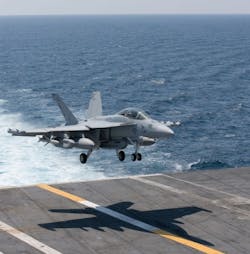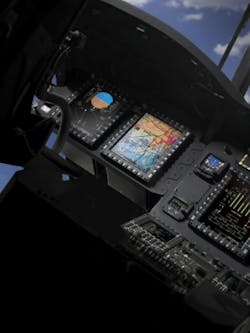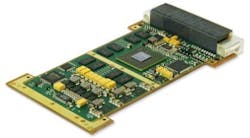Signal processing approaches for electronic warfare and signals intelligence spark debate
Special report -- Preferences among systems are divided for electronic warfare (EW) and signals intelligence (SIGINT) systems on the most efficient ways to implement digital signal processing (DSP). The battle lines are drawn among field-programmable gate arrays (FPGAs), general-purpose processors (GPPs), and the new breed of graphics processing units (GPUs).
The challenge of signal processing for electronic warfare and signals intelligence applications revolves around the sequence of events that happen in transforming raw RF signals at an antenna into useful information for fighting forces to use as they take some sort of action. To be effective, this sequence must be fast and efficient in converting signals from analog to digital, and filter out noise and other irrelevant RF energy, while processing data quickly to pull out the most important information from a flood of data.
This is a complex chain of events that demands many bits of advanced technology working together. Nevertheless, this process increasingly can be handled effectively and at reasonable cost with commercial off-the-shelf (COTS) electronic and embedded computing components.
This is a long way from where EW and SIGINT systems integrators were just 10 years ago. In those days and before, systems integrators for the most part had to use specialized proprietary components in custom designs tailored specifically to each individual application.
Suffice it to say that systems upgrades in those days were so difficult and expensive that engineers were discouraged from almost any attempt short of a complete system redesign. Technology insertion to meet evolving electronic warfare and signals intelligence threats either involved costly and time-consuming initiatives, or simply making do with the equipment available.
Today, however, much of that is changing, thanks to COTS signal processing technology that in a short amount of time has become increasingly capable, flexible, and reasonably priced. "With the advent of increasing densities of processors, I can process everything I need in COTS cards," says Joe Ottaviano, director of surface electronic warfare at the Lockheed Martin Corp. Mission Systems & Sensors segment in Syracuse, N.Y.
Today's COTS analog-to-digital converters, digital-to-analog converters, field-programmable gate arrays (FPGAs), and digital general-purpose processors (GPPs) are combining to tackle complex electronic warfare and signals intelligence problems more flexibly than ever before, with new COTS-based technological approaches waiting in the wings.
Tradeoffs among FPGAs, GPPs, and GPUs
Ever-more-powerful FPGAs from companies like Altera Corp. and Xilinx Inc. -- both based in San Jose, Calif. -- hold the potential for even faster and more efficient data filtering near the antenna, and graphics processing units (GPUs) such as the CUDA from NVIDIA Corp. in Santa Clara, Calif., are offering a powerful new generation of DSPs with parallel-processing capability for electronic warfare and signals intelligence.
Field-programmable gate arrays play a crucial part in today's electronic warfare and signals intelligence designs. These devices are helping to broaden the RF spectrum bandwidth that systems can monitor at one time, and also are reducing latency time in processing, which can be crucial in systems such as the U.S. Joint Counter RCIED (Radio Controlled Improvised Explosive Device) Electronic Warfare system -- better-known as JCREW.
This system is designed to detect RF signals emanating from cell phones, garage door openers, and other small hand-held devices intended to detonate improvised explosive devices (IEDs) and other roadside bombs. Essentially, JCREW detects these detonation signals, classifies them, and sends out a jamming signal before the IED can be detonated. It's an understatement to claim this kind of system requires fast processing.
The JCREW system needs to block the detonate signal before the IED can react and explode. "How quickly does that signal need to be intercepted before the device goes boom? We are not even talking milliseconds; it is very, very fast," says Jean Rheaume, director of programs for counter IED at the ITT Corp. Force Protection segment in Thousand Oaks, Calif. ITT is among the JCREW manufacturers.
"The FPGA versus general-purpose processor is one of the most important tradeoffs we pay attention to," Rheaume explains. "The tradeoff is very, very clear: if you can do it, you need to do as much in FPGAs as you can. The technology changes ever four to six months. You want efficiency and speed there as much as you can, and it is part of the tradeoff more and more."
The role of FPGAs
FPGAs in this kind of system play a big role in speeding signal processing from antenna to user display. Among their most valuable traits is their ability to do parallel processing. "It is useful to have an FPGA with parallel processing capability," says Ian Land, senior manager of military strategic marketing at FPGA designer Altera Corp. in San Jose, Calif. "An FPGA can process many data streams in parallel, as opposed to a DSP that is doing only one to four streams. An FPGA can look at 15 signals in interest at once, and then determine which of those 15 are truly interesting ones."
In a typical EW or SIGINT system, FPGAs handle much of the filtering of the raw data after it comes into the antenna and the A/D converts it to digital information. "Signals are coming in so fast, and there is so much data, that FPGAs are really the solution of choice for processing at the front end," explains Steve Edwards, chief technology officer at embedded computing specialist Curtiss-Wright Controls Embedded Computing in Ashburn, Va.
"The FPGA takes that huge amount of raw data and parses it down into something more capable for the processor to do more detailed processing," Edwards says. "The FPGA may run some filtering algorithm to look for pieces of data that might be of interest to the processor. It funnels that huge amount of data down to a manageable level."
Although FPGAs rarely handle the majority of signal processing in today's EW and SIGINT systems, these devices have particular strengths in these applications. "FPGAs are the king of I/O, so they are the first thing you hit" after digitizing the signal, explains Mark Couture, director of product management for the Microwave and Digital Solutions Group of Mercury Computer Systems in Salem, N.H.
"You may have 12 bits per sample, and it is coming at you at gigahertz rates," Couture says. "If you can decimate it down, or channelize it, that is often done in an FPGA." Although these devices may not be particularly useful for context-switching tasks, "they are very good at parallel data feeds, sophisticated filters, and digital downconverting," Couture says.
"As we look ahead at future FPGAs, we see the ability to do more floating-point algorithms in the FPGAs," says Denis Smetana, product marketing manager for FPGA products at Curtiss-Wright Controls Embedded Computing. "The advantage is the front-end is a very analog activity. If you are able to put some of that A/D functionality into the FPGA, you put the data into more of a digital domain, which is more reliable than analog data."
General-purpose processors (GPPs)
After the digital signal processing chain in electronic warfare and signals intelligence systems moves through the FPGA filtering phase, then it is time for floating-point-intensive general-purpose processors to take over, and the new 2nd Generation Intel Core i7 processors -- otherwise known as Sandy Bridge -- are among the most popular COTS chips on the market for this kind of application.
"We can do processing more efficiently now with the 2nd Gen Core i7, and we have a product with this processor coming out later this year," says Curtiss-Wright's Edwards. The latest Core i7 processors "give about a four-to-one performance improvement over the older Power Architecture products." The high performance of these new microprocessors helps systems designers reduce size, weight, and power (SWaP) "because you need fewer cards to achieve the same result," he says.
For years the general-purpose processor of choice for electronic warfare and signals intelligence applications was the AltiVec-based Power Architecture from Freescale Semiconductor Inc. in Austin, Texas. Freescale, however, temporarily discontinued the floating point processing support of AltiVec in some of its latest processors, and the Intel Core i7, with its floating point processing support, jumped in to fill the void.
"It was a big problem for us and our customers when Freescale discontinued AltiVec capability in their newest processors," says Michael Stern, product manager for military and aerospace high-performance computing at GE Intelligent Platforms in Towcester, England. "Sandy Bridge brings game-changing capabilities in DSP processing. The on-board graphics processing in the Sandy Bridge can also be looked at as a multi-core parallel-processing computer."
Of particular interest to EW and SIGINT designers is the Advanced Vector Extensions (AVX) of the 2nd Generation Core i7, which are 256-bit-wide floating point processing units, Stern explains. "They will grow over time, but even today it gives you up to 20 times the performance of an AltiVec-enabled MPC 8640 single- or dual-core processor," he says.
Graphics processing units (GPUs)
A new processing unit coming on the scene for electronic warfare, signals intelligence, and other DSP-intensive computing is the graphics processing unit (GPU), dominated today by the CUDA graphics processing unit from NVIDIA Corp. in Santa Clara, Calif. Although -- as the name implies -- GPUs are designed for processing graphics, DSP systems designers find they also function strongly in parallel processing and floating-point processing. Much like FPGAs, these new generations of GPUs are exceeding good at floating-point, which makes them particularly desirable for aerospace and defense DSP applications.
"When you need a ton of floating-point capability, this is where NVIDIA is often used as an accelerator," explains Mercury's Couture. The NVIDIA CUDA can hang off the Intel general-purpose processor and "are super floating-point engines," he explains.
It remains to be seen if GPUs will augment or replace FPGAs in DSP-intensive applications like EW and SIGINT. Some embedded computing experts say FPGAs always will be the best candidates for filtering and specialized computing, but others say they believe graphics processing units ultimately will eat into FPGA tasks and push FPGAs into niche applications in digital signal processing.
"GPUs are kind of like FPGAs. They are not good at context switching, because GPUs are able to perform massive amounts of linear algebra in these pipelines," Couture says. "You have to make sure you are feeding the animal, and if you just use a small coffee straw, you will not realize the real performance of these devices. If you use more GPUs, you get more processing power, but you can't change what you're doing very quickly."
GE Intelligent Platforms was among the first embedded computing companies to built NVIDIA CUDA-based products for aerospace and defense DSP applications, and other companies, such as Curtiss-Wright Controls Embedded Computing, will introduce GPU-based products later this year.
"CUDA is bringing high-performance computing into the rugged embedded military space," Stern says. Might the GPU begin to replace FPGAs in electronic warfare and signals intelligence applications? Stern says it's too early to tell. "In EW and SIGINT, there are usually some FPGA processors in those boxes, yet the GPU, because of its parallel architecture, does actually eat into the FPGA footprint. How much is up for grabs right now."
CUDA may have applications in data filtering just after A/D conversion, where until now the FPGAs have reigned supreme. "Some people choose to treat the front end of the EW system with lots of FPGAs, but CUDA and the Intel processors do eat into some of the reasons you would want to do some of these things in hardware," Stern says.
"In SIGINT, where you gather sensor data across the spectrum, CUDA offers some real advantages there in terms of throughput and resolution," Stern says. "It is a size, weight, and power thing -- especially for the people who want to fly these devices on aircraft."
Processor vs. FPGA debate
As the relative capabilities of FPGAs, general-purpose processors, and graphics processing units advance, the tasks for which these three separate components can perform in electronic warfare and signals intelligence applications blur, and spark a debate among systems designers on the best ways to put together a system.
The lines of contention in this debate center on the proper role of FPGAs, vs. the roles of general-purpose processors and graphics processing units. It is well-acknowledged that FPGAs can offer superior computing power, flexibility, as well as smaller size, weight, and power consumption than GPPs and GPUs. The drawback to FPGAs, however, is their relative difficulty in programming. FPGAs require knowledge and skill in the VHSIC Hardware Description Language (VHDL), while much of the GPP and GPU programming can make do with C++ or another high-order software language.
BittWare Inc. in Concord, N.H., comes down firmly in the FPGA camp, and works exclusively with Altera as its FPGA supplier. Even though FPGA-dominated EW and SIGINT systems may be more labor-intensive to build, the small size, weight, and power consumption of these systems is worth it, says Jeff Milrod, BittWare's president and chief executive officer.
"The choice today is high-end processing and low-end FPGA processing, where you have to make everything yourself," Milrod explains. "Either people say we will go FPGA and always squeeze all the performance out of it we can, or go to associated layers of software, and that is inefficient. Look at the cooling requirements of general-purpose processors and graphics processing units," Milrod continues. "People are just burning too much power. People want to make the software easy at the expense of power and heat."
In a performance comparison alone, FPGAs have the advantage, insists Altera's Land. "When you look at ourselves vs. ASICs [application-specific integrated circuits], CPUs, GPUs, and DSPs, the FPGA always wins; it is just a better product today. We are typically smaller and lower power, and ASICs are difficult to use in military applications.
Milrod acknowledges that the embedded computing industry as a whole may has insufficient in-house skill to do widespread processing in FPGAs, rather than with GPPs and GPUs. Still, he says systems integrators should consider FPGAs for the advantages they present.
Much of the decisions on how and where to use FPGAs, GPPs, and GPUs in electronic warfare and signals intelligence systems boils down to how small the fielded system must be, says Jim Shea, vice president and general manager of DRS Signal Solutions in Gaithersburg, Md.
"For the small hand-held device, you pretty much have to go the FPGA route," Shea explains. Some designers even might want to consider both approaches as they shrink their systems for mobile and hand-held use. "Many of our customers start with a software-intensive approach to get them in the field quickly, and then they go to VHDL and load that into a product with FPGAs."
Just where to draw the line between the FPGA and GPP/GPU approaches, however, is difficult to gauge. "The line of where you jump from general-purpose processors to FPGAs is constantly moving. I think the two -- GPPs and FPGAs -- will co-exist for a long time."




